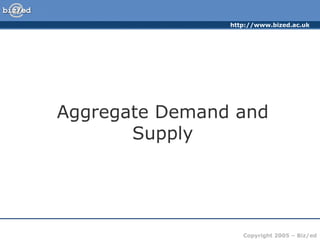
Adas 1
- 1. Aggregate Demand and Supply
- 2. Aggregate Demand and Supply
- 8. Aggregate Demand Curve Inflation Real National Income AD 2.0% Y1 At an inflation level of 2%, the AD curve gives a level of output of Y1 This level of output will be associated with a particular level of unemployment which we will call U = 5% U = 5% 3.0% Y2 At a higher rate of inflation (3.0%) rising interest rates mean that C, I and (X-M) all have negative effects on AD – NY falls to Y2 U = 7% The lower level of National Income requires fewer units of labour – unemployment rises to 7% shown by U = 7%
- 9. Shifts in the Aggregate Demand Curve Inflation Real National Income AD 2.0% Y1 U = 5% Shifts in AD will be caused by changes in factors affecting C, I, G and (X-M) (exogenous factors) e.g. increasing income tax rates affect consumption AD2 Y2 U = 2% Any exogenous factor causing C, I or G to rise, or a trade surplus causes a shift to the right in AD This would cause a rise in national income (economic growth) and lead to a fall in unemployment (U = 2%) (and vice versa)
- 15. Key Variables
- 21. Aggregate Supply Inflation Real National Income The shape of the AS curve is important in determining the outcome in the economy AS Yf This shape reflects a Keynesian view of the AS curve. Yf represents ‘Full Employment Output’ – at this point the economy is working to full capacity and cannot produce any more. Y1 An output level of Y1 would suggest the economy is working below full capacity and there would be widespread unemployment. Economy starts to overheat Between Y1 and Yf, increases in capacity are possible but the nearer the economy gets to Yf, the more problems are experienced with acquiring resources to boost production (production bottlenecks) especially labour skills shortages.
- 22. Aggregate Supply Inflation Real National Income AS1 AS2 Yf1 Yf2 Increases in capacity can occur as a result of a shift in AS (akin to a shift outwards of the Production Possibility Frontier) (PPF)
- 23. Aggregate Supply Inflation Real National Income SRAS Short run aggregate supply (SRAS) assumes firms only able to increase output at higher costs (e.g. overtime payments) thereby pushing up price level SRAS 1 SRAS 2 SRAS assumes costs such as overall wage rate remain fixed, changes in such costs cause a shift in the SRAS curve (exogenous shocks – input costs)
- 24. Aggregate Supply Inflation Real National Income LRAS Classical economists assume the long run aggregate supply curve (LRAS) is vertical (perfectly inelastic). This is because they believe that in the long run, there will be no unemployment of resources because markets will clear, thus whatever the rate of inflation, firms will supply the maximum capacity of the economy. Yf
- 25. Aggregate Supply For our analysis, we will assume the AS curve looks like this! Inflation Real National Income AS
- 26. Putting AD and AS together Inflation Real National Income AS Yf AD 2.0% Y1 In this situation, the economy would be operating at less than capacity, there would be unemployment and the economy might be growing only slowly. AD 1 Y2 2.5% A shift in the AD curve to AD1 as a result of a change in any or all of the factors affecting AD would increase growth, reduce unemployment but at a cost of higher inflation (a trade-off)
- 27. Putting AD and AS together Inflation Real National Income AS Yf AD 2.0% Y1 AD1 Y2 2.5% AD2 3.5% Further increases in AD would lead to successively smaller increases in growth and employment at the cost of ever higher inflation. Y3
- 28. Sustained Growth Inflation Real National Income AD AS 2.0% Y1 AS1 Y2 AD2 Sustained growth (not to be confused with sustainable economic growth) occurs when AS and AD rise at similar rates – national income can rise without effects on inflation